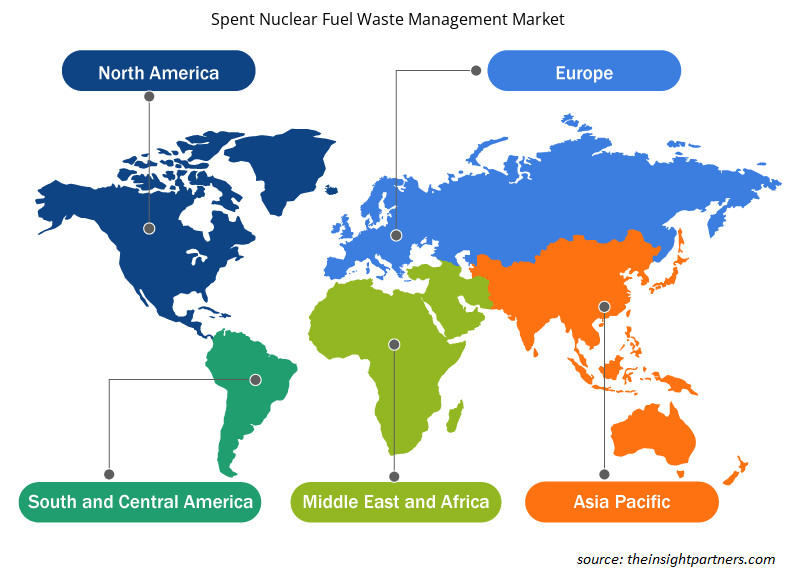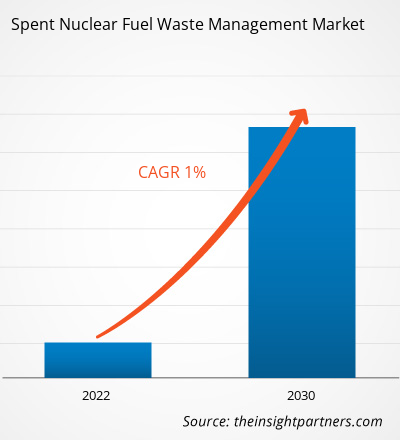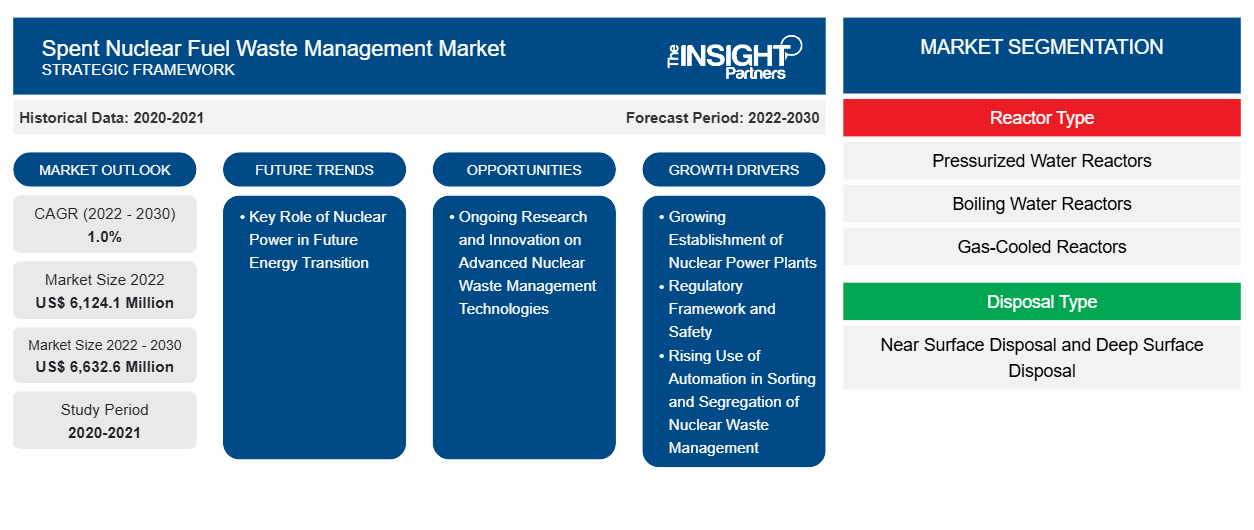من المتوقع أن يصل حجم سوق إدارة نفايات الوقود النووي المستهلك إلى 6,632.6 مليون دولار أمريكي بحلول عام 2030 من 6,124.1 مليون دولار أمريكي في عام 2022. ومن المتوقع أن يسجل السوق معدل نمو سنوي مركب بنسبة 1.0٪ في الفترة 2022-2030. تعد السياسات الحكومية المتنامية والتفويضات التي تفضل إدارة النفايات النووية وتهدف إلى تحقيق أهداف الانبعاثات الكربونية الصفرية الجديدة من بين العوامل الرئيسية التي تدفع سوق إدارة نفايات الوقود النووي المستهلك.
تحليل سوق إدارة نفايات الوقود النووي المستهلك
من المتوقع أن يشهد سوق إدارة نفايات الوقود النووي المستهلك العالمي نموًا كبيرًا خلال الإطار الزمني الذي تم تحليله نظرًا للعدد المتزايد من المشاريع النووية بالإضافة إلى اللوائح المتزايدة تجاه إدارة نفايات الوقود النووي المستهلك. بالإضافة إلى ذلك، فإن تطوير التخلص الجيولوجي العميق لإدارة النفايات النووية في مرحلة متقدمة ومن المتوقع أن يحقق هدف الاستدامة البيئية. إن الاستثمار المتزايد في البنية التحتية لإدارة النفايات النووية بشكل عام لتسهيل إدارة أفضل للوقود النووي المستخدم، يعزز سوق إدارة نفايات الوقود النووي المستهلك في العالم.
نظرة عامة على سوق إدارة نفايات الوقود النووي المستهلك
مع تزايد عدد السكان والتصنيع، يرتفع الطلب على الطاقة أيضًا على المستوى العالمي. كما أدى ارتفاع استهلاك الطاقة إلى تعزيز الحاجة إلى توليد الطاقة النووية. وقد أدى هذا إلى دفع الطلب على سوق إدارة نفايات الوقود النووي المستهلك في جميع أنحاء العالم. في بعض البلدان، يتم بالفعل استخدام التقنيات المتقدمة والمبتكرة لإعادة معالجة الوقود المستهلك وإعادة تدوير المواد القابلة للاستخدام، مثل البلوتونيوم واليورانيوم، من خلال إنتاج واستخدام وقود الموكس. في بعض البلدان، يتم تطوير تقنيات إعادة المعالجة الأكثر تعقيدًا لإعادة تدوير النويدات المشعة الخصبة وطويلة العمر أيضًا من أجل جعل دورة الوقود النووي مستدامة وتقليل كمية وسمية النفايات الإشعاعية التي يجب التخلص منها في النهاية. تهدف تقنيات إعادة التدوير هذه إلى دعم استخدام وقود المفاعلات السريعة في الأمد البعيد.
قم بتخصيص هذا التقرير ليناسب متطلباتك
ستحصل على تخصيص لأي تقرير - مجانًا - بما في ذلك أجزاء من هذا التقرير، أو تحليل على مستوى الدولة، وحزمة بيانات Excel، بالإضافة إلى الاستفادة من العروض والخصومات الرائعة للشركات الناشئة والجامعات
-
احصل على أهم اتجاهات السوق الرئيسية لهذا التقرير.ستتضمن هذه العينة المجانية تحليلاً للبيانات، بدءًا من اتجاهات السوق وحتى التقديرات والتوقعات.
محركات وفرص سوق إدارة نفايات الوقود النووي المستهلك
تزايد إنشاء مرافق الطاقة النووية
ومن المتوقع أن يؤدي ارتفاع الطلب على الطاقة مع التصنيع السريع والتحضر في جميع أنحاء العالم إلى دفع نمو توليد الطاقة النووية، والذي من المتوقع بدوره أن يغذي الحاجة إلى زيادة إنشاء مرافق الطاقة النووية في السنوات القادمة. يوجد اليوم حوالي 440 مفاعلًا نوويًا قيد التشغيل في 32 دولة وتايوان، بسعة إجمالية تبلغ حوالي 390 جيجاوات كهربائية. وفي عام 2022، وفر هذا 2545 تيراوات في الساعة، أي حوالي 10٪ من كهرباء العالم. تخطط العديد من البلدان التي لديها برامج طاقة نووية قائمة لبناء أو هي في طور بناء مفاعلات طاقة جديدة. وعلى الرغم من العدد الكبير من هذه الاقتصادات الناشئة، فمن غير المتوقع أن تقدم مساهمة كبيرة في توسيع القدرة النووية في المستقبل المنظور - سيحدث النمو الرئيسي في البلدان التي ترسخت فيها التكنولوجيا بالفعل. وبالتالي، من المتوقع أن تؤدي الحاجة المتزايدة للطاقة في جميع أنحاء العالم إلى تغذية إنشاء محطات الطاقة النووية المتزايدة من عام 2022 إلى عام 2030، والذي من المتوقع بدوره أن يدفع سوق إدارة نفايات الوقود النووي المستهلك في السنوات القادمة.
الدور الرئيسي للطاقة النووية في التحول المستقبلي للطاقة النظيفة وأمن الطاقة
تبلغ حصة الطاقة النووية في إجمالي توليد الطاقة العالمية حوالي 10%، وترتفع إلى ما يقرب من 20% في الاقتصادات المتقدمة. تاريخيًا، كانت واحدة من أكبر موردي الكهرباء الخالية من الكربون في العالم. وعلى الرغم من أنها تواجه تحديات رئيسية في بعض البلدان، إلا أنها تتمتع بإمكانات كبيرة للمساهمة في إزالة الكربون من قطاع الطاقة. بالإضافة إلى ذلك، تساهم محطات الطاقة النووية في أمن الطاقة بعدة طرق، حيث تحافظ على استقرار شبكات الطاقة وتكمل استراتيجيات إزالة الكربون، حيث يمكنها تكييف إنتاجها إلى حد ما استجابة للتغيرات الرئيسية في الطلب والعرض. ومع زيادة حصة الطاقات المتجددة المتغيرة، مثل طاقة الرياح والطاقة الكهروضوئية، ستزداد الحاجة إلى مثل هذه الخدمات. وبالتالي، من المتوقع أن يخلق الدور المهم للطاقة النووية في التحول المستقبلي للطاقة النظيفة وأمن الطاقة فرصًا للشركات الرئيسية العاملة في قطاع إدارة نفايات الوقود النووي المستهلك من عام 2022 إلى عام 2030.
تقرير تحليل تجزئة سوق إدارة نفايات الوقود النووي المستهلك
إن القطاعات الرئيسية التي ساهمت في اشتقاق تحليل سوق إدارة نفايات الوقود النووي المستهلك هي نوع المفاعل ونوع التخلص منه.
- بناءً على نوع المفاعل، تم تقسيم سوق إدارة نفايات الوقود النووي المستهلك إلى مفاعلات الماء المضغوط (PWR)، ومفاعلات الماء المغلي (BWR)، والمفاعلات المبردة بالغاز، وغيرها. احتلت شريحة مفاعلات الماء المضغوط (PWR) حصة سوقية أكبر في عام 2022.
- بناءً على نوع التخلص، تم تقسيم سوق إدارة نفايات الوقود النووي المستهلك إلى التخلص بالقرب من السطح والتخلص من السطح العميق . احتل قطاع التخلص من السطح العميق حصة سوقية أكبر في عام 2022.
تحليل حصة سوق إدارة نفايات الوقود النووي المستهلك حسب المنطقة الجغرافية
ينقسم النطاق الجغرافي لتقرير سوق إدارة نفايات الوقود النووي المستهلك بشكل أساسي إلى خمس مناطق: أمريكا الشمالية وأوروبا وآسيا والمحيط الهادئ والشرق الأوسط وأفريقيا وأمريكا الجنوبية.
سيطرت أوروبا على سوق إدارة نفايات الوقود النووي المستهلك في عام 2022. وتشمل المنطقة الأوروبية ألمانيا وفرنسا وإسبانيا وروسيا والمملكة المتحدة وبقية أوروبا. ويرجع ارتفاع الطلب على الطاقة إلى زيادة أو تباين أسعار النفط والغاز بسبب التوترات الجيوسياسية في جميع أنحاء مناطق أوروبا والشرق الأوسط. ومؤخرًا، قررت بلجيكا تمديد تشغيل مفاعلين حاليين من عام 2025 إلى عام 2035، وهو ما سيغطي حوالي 15٪ من احتياجات الكهرباء. بالإضافة إلى ذلك، بدأت وحدة أولكيلوتو 3 الفنلندية العمل رسميًا في أبريل 2023، وهي أول مفاعل نووي جديد في أوروبا الغربية منذ 15 عامًا. علاوة على ذلك، وافقت فرنسا في عام 2022 على بناء ستة مفاعلات نووية كبيرة جديدة تلبي حوالي 10٪ من احتياجات الكهرباء، مع خيار بناء ثمانية مفاعلات أخرى. ومن المقرر تشغيل المفاعل الأول في عام 2035.
رؤى إقليمية حول سوق إدارة نفايات الوقود النووي المستهلك
لقد قام المحللون في Insight Partners بشرح الاتجاهات والعوامل الإقليمية المؤثرة على سوق إدارة نفايات الوقود النووي المستهلك طوال فترة التوقعات بشكل شامل. يناقش هذا القسم أيضًا قطاعات سوق إدارة نفايات الوقود النووي المستهلك والجغرافيا في جميع أنحاء أمريكا الشمالية وأوروبا ومنطقة آسيا والمحيط الهادئ والشرق الأوسط وأفريقيا وأمريكا الجنوبية والوسطى.

- احصل على البيانات الإقليمية المحددة لسوق إدارة نفايات الوقود النووي المستهلك
نطاق تقرير سوق إدارة نفايات الوقود النووي المستهلك
| سمة التقرير | تفاصيل |
|---|---|
| حجم السوق في عام 2022 | 6,124.1 مليون دولار أمريكي |
| حجم السوق بحلول عام 2030 | 6,632.6 مليون دولار أمريكي |
| معدل النمو السنوي المركب العالمي (2022 - 2030) | 1.0% |
| البيانات التاريخية | 2020-2021 |
| فترة التنبؤ | 2022-2030 |
| القطاعات المغطاة |
حسب نوع المفاعل
|
| المناطق والدول المغطاة |
أمريكا الشمالية
|
| قادة السوق وملفات تعريف الشركات الرئيسية |
|
كثافة اللاعبين في سوق إدارة نفايات الوقود النووي المستهلك: فهم تأثيرها على ديناميكيات الأعمال
يشهد سوق إدارة نفايات الوقود النووي المستهلك نموًا سريعًا، مدفوعًا بالطلب المتزايد من المستخدم النهائي بسبب عوامل مثل تفضيلات المستهلكين المتطورة والتقدم التكنولوجي والوعي الأكبر بفوائد المنتج. ومع ارتفاع الطلب، تعمل الشركات على توسيع عروضها والابتكار لتلبية احتياجات المستهلكين والاستفادة من الاتجاهات الناشئة، مما يؤدي إلى زيادة نمو السوق.
تشير كثافة اللاعبين في السوق إلى توزيع الشركات أو المؤسسات العاملة في سوق أو صناعة معينة. وهي تشير إلى عدد المنافسين (اللاعبين في السوق) الموجودين في مساحة سوق معينة نسبة إلى حجمها أو قيمتها السوقية الإجمالية.
الشركات الرئيسية العاملة في سوق إدارة نفايات الوقود النووي المستهلك هي:
- شركة أوجيان المحدودة
- شركة بيرما فيكس للخدمات البيئية
- سفينسك كارنبرانسليهانترينغ AB
- أنسالدو إنيرجيا إس بي إيه
- مؤسسة علم البيئة الأمريكية
- مجموعة فيوليا
إخلاء المسؤولية : الشركات المذكورة أعلاه ليست مرتبة بأي ترتيب معين.

- احصل على نظرة عامة على أهم اللاعبين الرئيسيين في سوق إدارة نفايات الوقود النووي المستهلك
أخبار سوق إدارة نفايات الوقود النووي المستهلك والتطورات الأخيرة
يتم تقييم قطاع إدارة نفايات الوقود النووي المستهلك من خلال جمع البيانات النوعية والكمية بعد البحث الأولي والثانوي، والتي تتضمن منشورات الشركات المهمة وبيانات الجمعيات وقواعد البيانات. فيما يلي قائمة بالتطورات في سوق إدارة نفايات الوقود النووي المستهلك والاستراتيجيات:
- في يوليو 2023، دخلت شركة Perma-Fix Environmental Services في شراكة مع نقابة United Association of Plumbers and Steamfitters المحلية 598. تهدف هذه الشراكة إلى توفير خيارات معالجة النفايات والتي من المتوقع أن تعمل على تسريع إجراءات إصلاح خزان هانفورد.
- في يناير 2020، وقعت شركة فيوليا أمريكا الشمالية، وهي شركة تابعة لمجموعة فيوليا، اتفاقية لتوسيع نشاطها في معالجة النفايات الخطرة وإعادة التدوير من خلال شراء موقع معالجة النفايات الخطرة لشركة ألكوا يو إس إيه كوربوريشن الواقع في جوم سبرينجز، الولايات المتحدة.
تقرير سوق إدارة نفايات الوقود النووي المستهلك والتغطية والنتائج المتوقعة
يوفر تقرير "حجم سوق إدارة نفايات الوقود النووي المستهلك والتوقعات (2020-2030)" تحليلاً مفصلاً للسوق يغطي المجالات التالية:
- حجم السوق والتوقعات على المستويات العالمية والإقليمية والوطنية لجميع قطاعات السوق الرئيسية التي يغطيها النطاق
- ديناميكيات السوق مثل المحركات والقيود والفرص الرئيسية
- الاتجاهات المستقبلية الرئيسية
- تحليل مفصل لقوى بورتر الخمس
- تحليل السوق العالمي والإقليمي الذي يغطي اتجاهات السوق الرئيسية واللاعبين الرئيسيين واللوائح والتطورات الأخيرة في السوق
- تحليل المشهد الصناعي والمنافسة الذي يغطي تركيز السوق، وتحليل خريطة الحرارة، واللاعبين البارزين، والتطورات الأخيرة
- ملفات تعريف تفصيلية للشركة مع تحليل SWOT
- التحليل التاريخي (سنتان)، سنة الأساس، التوقعات (7 سنوات) مع معدل النمو السنوي المركب
- تحليل PEST و SWOT
- حجم السوق والقيمة / الحجم - عالمي، إقليمي، بلد
- الصناعة والمنافسة
- مجموعة بيانات إكسل
التقارير الحديثة
تقارير ذات صلة
شهادات العملاء
سبب الشراء
- اتخاذ قرارات مدروسة
- فهم ديناميكيات السوق
- تحليل المنافسة
- رؤى العملاء
- توقعات السوق
- تخفيف المخاطر
- التخطيط الاستراتيجي
- مبررات الاستثمار
- تحديد الأسواق الناشئة
- تحسين استراتيجيات التسويق
- تعزيز الكفاءة التشغيلية
- مواكبة التوجهات التنظيمية























 احصل على عينة مجانية ل - سوق إدارة نفايات الوقود النووي المستهلك
احصل على عينة مجانية ل - سوق إدارة نفايات الوقود النووي المستهلك